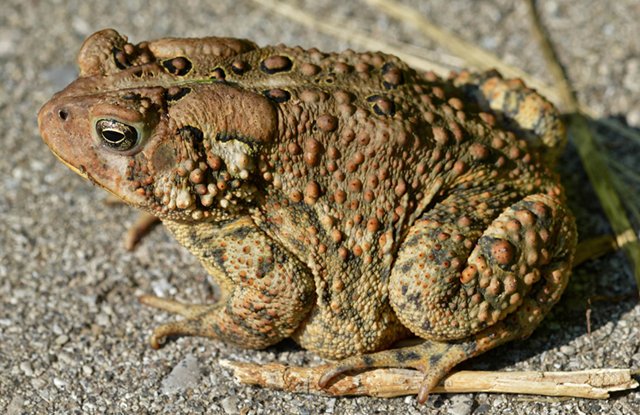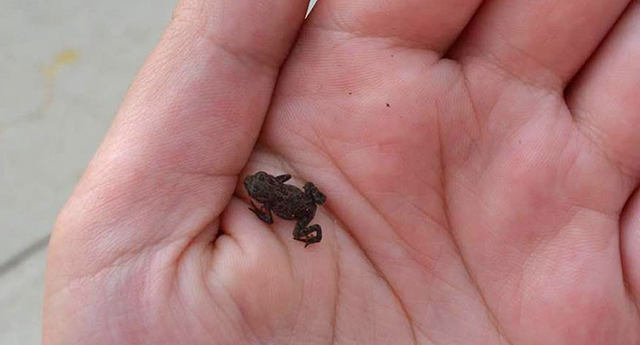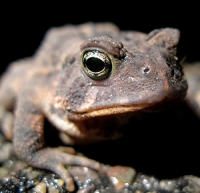Folklore
Typical toad misconceptions stem from its mythological association with witches. Common legends from the middle ages describe the toad as a familiar, a kind of supernatural entity in the guise of an animal that would assist witches in the practice of their magic.

This woodcut from 1579 depicts a witch feeding her toad familiars.
Later, in the 1600's, the toad as an ingredient in witch's brew would be popularized in Shakespeare's Macbeth:
Round about the cauldron go;
In the poison'd entrails throw.
Toad, that under cold stone
Days and nights has thirty-one
Swelter'd venom sleeping got,
Boil thou first i' the charmed pot.
Of course the number one toad misnomer is that touching one will cause warts. Well, leave the wart-making to Shakespeare's witches, because I can assure you the wart inducing myth has been busted. Handling a toad will NOT give one warts (which are actually caused by a unrelated virus). The toad is in fact a happy-go-lucky little critter that doesn’t deserve the shrieks and screeches I’ve often seen it induce.
Fact
The Eastern America Toad (Anaxyrus americanus formerly Bufo americanus) is Wisconsin’s only toad species. It is a common amphibian in Wisconsin living in every county throughout. They are found in habitats ranging from woodlands and wetlands to fields and prairies. More adaptable than most other frog species (likely because of their ability to live in drier conditions), they can even be found in backyards and gardens. In fact, many gardeners provide toad houses to welcome toads to their yards because toads are big consumers of slugs. They also readily eat grasshoppers, spiders, worms and other types of invertebrates.

Eastern America Toad (Anaxyrus americanus). Photo: Ryan Hodnett
Toads are two to four inches in size, yellowish, brownish, or gray in color, with bumpy dry skin and spots. The large warts behind the eyes - the paratoid glands - can secrete a toxic chemical (bufotoxin) which acts as a defense. This secretion is an irritant to the eyes and mouths of predators, and if swallowed, can cause severe vomiting and diarrhea. (I have a childhood memory of a neighbor whose dog thrice ended up at the emergency veterinary room because her dog had developed an unusual taste for toads. It is also for this reason that one should wash hands before touching their eyes after handling a toad.)
The hearing and vision of toads is well-developed. Large, bulging eyes see color well and detect movement to hone in on prey. Their ears are flat rounds discs (tympanum) located behind the eyes that consist of an eardrum, middle ear (sound-transmitting bones) and inner ear (to transmit sound to the brain). It is believed that some frog species use their acute hearing to listen for long rains while overwintering underground which may signal the arrival of spring. Additionally, their hearing is so fine-tuned that a female can identify her own offspring’s call out a deafening frog chorus of mixed species, so as to avoid interbreeding.

In this closeup view you can clearly see the round disc behind the toad's eye that make up its tympanum (ears), and the wart-like paratoid glands just above and to the left.
Toads are less reliant on water than frogs. Adults still rely on water to lay their eggs, but their thick warty skin is much better adapted for retaining moisture than aquatic frogs. Eggs are laid in water in clear gelatinous strings sometimes attached to aquatic vegetation and measuring up to 12 inches in length. The eggs will hatch in 2-14 days depending on the warmth of the water. Tadpoles have tiny teeth (denticles) which feed on algae and aquatic vegetation until they completely metamorphose at about six weeks of age.
Once a toad has completed its metamorphose it is considered a toadlet. A toadlet might hang around the pond for another week or two but will eventually leave the pond to acclimate to a more terrestrial life.

This tiny toadlet was making its way from the pond at our Riverside Park branch last year! Photo: Maddie Bird
Just like birds and many invertebrates, toads undergo an annual migration. Every spring, they use the moon to navigate to their original location of birth. They will return to their birth-site to breed and will return to it every year to breed thereafter. The migration is typically a few hundred meters, but can be up to a few miles in length.
The internal homing device that drives a toad’s (or any frog’s) migration is a complicated process not yet fully understood by scientists. However, it is understood that their instinct is so keen that they are often seen returning to the exact same entry point (e.g. two feet next to the mulberry at the edge of the pond between the cattails and the green bench) in the pond year after year. Unfortunately, the instinct is also so overwhelming that it sometimes allows frogs to return to unsuitable breeding sites that may have dried up or been developed since their birth.
Once the breeding season is over, both frogs and toads will make a fall migration to their overwintering grounds. Where they overwinter is determined by the species. Frogs will overwinter at the bottoms of ponds or under deep leaf litter. Toads typically burrow beneath the ground at or just below the frost line. They can freeze portions of their body and will remain in a catatonic state until the spring. Since a toad’s lifespan is on average 5-7 years, it will repeat this migration and overwintering process several times in its life.
Toad-ally Awesome Facts:
- They are literally as old as the hills. Toads and frogs were some of the first vertebrates to appear in fossil record. Frog-like species showed up some 200 million years ago. For reference, that is about 30 million years before the first dinosaurs appeared.
- You kiss your Mom with that mouth?! As a toadlet becomes a toad, it grows in size. It will shed its skin periodically as it outgrows its current skin and result in what is called a molt. The toad (or frog) starts molting with a split of skin down its back and will pull its legs out from there. Using is hands to assist, it will eventually work the skin up toward its face and into its mouth where it rids the skin by eating it.
- Perhaps they majored in linguistics? Frogs and toads are the only amphibians that use organized sound. They have separate calls for distress, warning, and mating and individual species have their own unique calls. As an aside, the Urban Ecology Center conducts auditory frog call counts every spring and anyone interested can participate. Click here to listen to a toad song.
For more information about frog call surveys, This email address is being protected from spambots. You need JavaScript enabled to view it.. - Get your dirty paws off of me! Amphibians have skin that is very sensitive and helps aid in breathing. It is for that reason that one should be careful when handling toads or other amphibians. Lotions, spicy food chemicals, and bug sprays can be transferred from our hands onto the critter and cause large burns on their skin. If the burns are severe enough, the amphibian will not be able to breathe properly and will die.
- A flock of tadpoles? Toad tadpoles are easily identified because they are the only frog species whose tadpoles flock. Much like a starling murmuration, the tadpoles stay close together moving and turning almost as if one organism in what is known to biologists as a swarm.
- Mr. Toad’s wild eyes… Toad eyes not only help them see, but they also help them eat. What?! Yes, their eyes are so big and deeply recessed into their heads that the bottom of the eyes press against their food while they chew and help grind it down to a more palatable size.
References:
*This article was written using references from the books Reptiles and Amphibian of Wisconsin by Stan Tekiela and Amphibians of Wisconsin by Rebecca Christoffel, Robery Hay, and Michelle Wolfgram and the websites Wikipedia.org, pwrc.usgs.gov, and wi.dnr.gov.
*Images:





